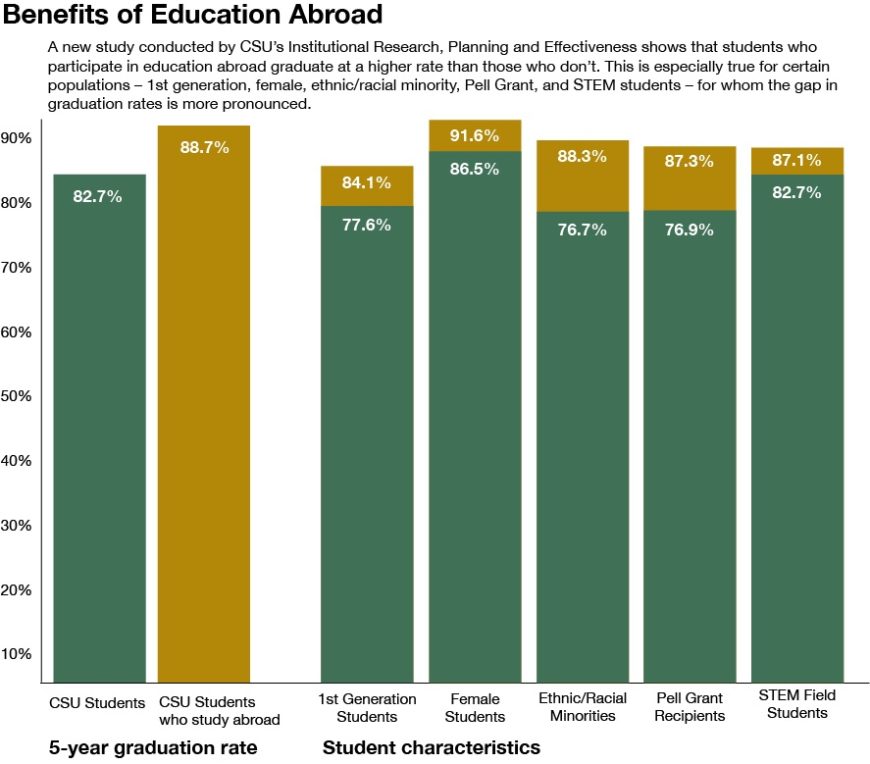
A new study shows that Colorado State University students who participate in education abroad graduate at a higher rate than those who don’t participate in education abroad.
The analysis, conducted by CSU’s Institutional Research, Planning and Effectiveness, examined first-time, full-time undergraduate students (between 2009 and 2012) who progressed to their third fall semester. Results showed that among these students, students who completed an international study, research, internship or service-learning program abroad had a 6 percentage-point advantage in their five-year graduation rate (88.7 percent) compared to students who did not study abroad (82.7 percent).
The study also analyzed the effects of education abroad on the graduation rates for first-generation, female, ethnic/racial minority, Pell grant recipients and STEM major students. The gap in graduation rates was even higher among certain subpopulations.
“In particular, the graduation rates of students of an underrepresented race/ethnicity were disproportionately and positively impacted by an education abroad experience, as well as students who are Pell recipients or first-generation,” said Jennifer Schneider, learning research analyst with Institutional Research, Planning and Effectiveness. “Results also suggest that education abroad experiences may have a particular positive impact on graduation rates among students with an average admission index score of 115 or lower.” (A student’s index score is calculated while in high school, using a combination of GPA or high school rank percentage combined with ACT or SAT score, to predict how well a student will do in college.)

Benefits apparent
Students of an underrepresented race/ethnicity had a five-year graduation rate that was 11.6 percentage points higher than underrepresented students who did not participate in education abroad. Among Pell grant recipients, or students with low family incomes, the graduation rate was 10.4 percentage points higher for education abroad students compared to no education abroad experience.
Students who participated in education abroad took slightly longer to graduate, on average in 4.75 years, than those who didn’t study abroad, who earned their degrees on average in 4.42 years. That difference amounts to one-third of a year, or the equivalent of one summer term. CSU Education Abroad is actively working on closing that gap with strategic programming abroad that is expected to reduce the time to graduation; the analysis will be ongoing.
Despite a common misconception that education abroad participants are generally students with higher academic performance, the results of the analysis showed the average academic admission index of education abroad participants to be 116.41, just slightly higher than the 115.56 average of non-participants who persisted to their third year.
Planning ahead
Students are encouraged to start planning early to go abroad. With proper planning, they can choose a program that fits best within their academic and personal goals, and can learn more about funding options.
As part of a new CSU initiative, incoming freshmen and transfer students are being encouraged to get a passport as soon as possible as a first step in taking advantage of the hundreds of international opportunities available. And to empower first-time travelers, donors are sponsoring more 100 passports each year for students who have not already been abroad.
Students can start to explore opportunities on the Education Abroad website or in person at Laurel Hall to talk to a student peer adviser or a professional staff adviser.
Making Education Abroad more accessible
In 2015, Colorado State University signed the Institute of International Education’s Generation Study Abroad pledge, vowing to increase participation by 100 students annually until 2020. To meet this goal, CSU Education Abroad has worked to make international experiences more accessible. This includes the development of more short-term faculty-led programs, which are popular because of their academic relevance and scheduling convenience – they can be completed during winter and spring breaks, or over the summer – and by removing more financial barriers by increasing CSU-administered scholarship funds up to $450,000 annually.
“As we try to empower and develop the next generation of globally-minded citizens, we really need to be aware of the opportunities in and barriers to an education abroad,” says Laura Thornes, director of Education Abroad at CSU. “Fortunately, CSU is already an internationally open community mindful of access and inclusion. We have had so many advocates and stakeholders across campus helping to remove barriers to education abroad through teaching, advocacy, investment, and data-informed decisions.”
During the 2016-17 academic year, approximately 1,375 CSU students participated in study, research, internship and service-learning programs abroad. Education Abroad, within the Office of International Programs, promotes more than 900 opportunities in over 85 countries to CSU students.